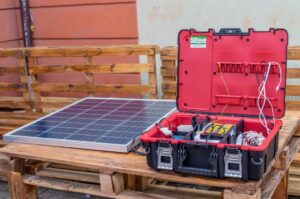
In response to the challenges of the war, the Department of Energy Management and Technical Diagnostics of the Ivano-Frankivsk Technical University of Oil and Gas (IFTUOG) began to design various types of mobile power stations for the needs of Ukrainians who live in the complicated condition in the front-line areas of Ukraine.
28 such stations, equipped with photovoltaic batteries, were delivered to Chernihiv, Mykolaiv, Zaporizhzhia, Kharkiv, and Donetsk oblasts for the needs of local communities. Now, these mobile power stations help maintain communications in war-struck regions and provide lighting when needed.
This significant contribution to Ukraine’s perseverance against russian full-scale invasion was made possible due to the USAID Energy Security Project (ESP) support, which helped to create the infrastructure for the installation and tuning of equipment and solar power plant systems at the Department and support provided by the Ukrainian-Swiss Fund Ukrainehilfe GR, which financed the production of the power stations for civilians.
According to Andrii Iavorskyi, Ph.D., Associate Professor of the Department of Energy Management and Technical Diagnostics of the Ivano-Frankivsk National Technical University of Oil and Gas, his team created simple options that could only charge mobile phones, but later they decided to move on to producing battery-operated stations.

Currently, specialists are working on three models of charging stations: a mobile station without an inverter for charging gadgets and lighting; a mobile station with an inverter for charging equipment powered by 220 V in an alternating current network (for example, Starlink); a mobile carry-on super lightweight model of a station which with the help of a solar panel allows you to charge power banks, mobile phones, etc.
Russia’s military strikes aim to destroy critical infrastructure, primarily energy infrastructure, hitting thermal power plants (TPPs) and combined heat and power (CHPs), damaging transformers and power lines, etc.
These attacks by the aggressor have severe consequences for civilians, whose homes are cut from electricity, heat, and water supply.
That is why autonomy and energy independence are necessary, especially in the oblasts affected by active hostilities.
Thanks to USAID ESP support, the Department’s classrooms can access scale models of solar panels, wind turbines, heat pumps, hydrogen generators, and other renewable energy equipment.
USAID ESP’s support has helped Ukrainian renewable energy research and development leap forward and has now become an essential asset in helping the border regions most affected by the war to persevere.
